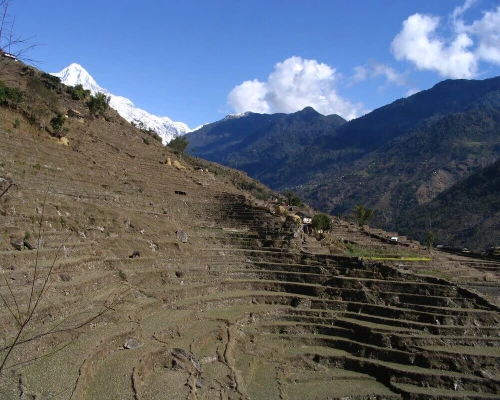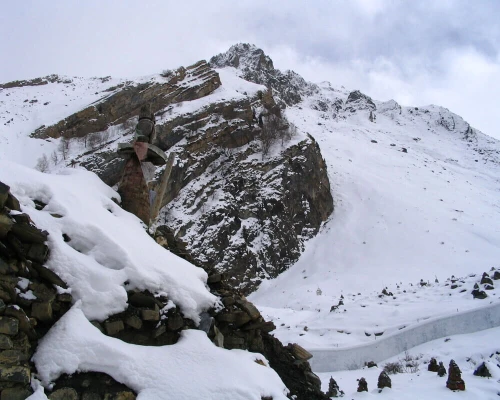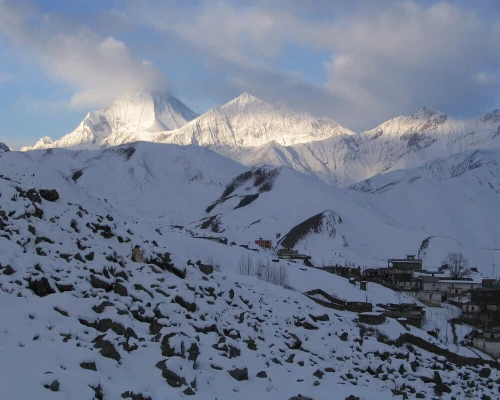Short Annapurna Circuit Trek is an 11 day trek that offers breathtaking panoramic views of the Himalayas, including peaks like Dhaulagiri, Annapurna I, and Manaslu. You will have the opportunity to explore Tibetan-style Buddhist villages and experience the rich culture of the Manang settlements. The trek takes you through diverse climatic zones, from rice paddy fields to subtropical forests and glacial areas. Along the way, you might spot wildlife such as blue sheep and even have a chance encounter with a snow leopard in Yak Kharka. The journey includes a visit to Jomsom's bustling market and a relaxing stop at the famous hot springs in Tatopani.
The trek begins in Kathmandu, where you take a local bus to Besisahar and continue to Chame. From there, you trek through Pisang, Manang, Ledar, and Thorong Phedi before crossing the Thorong La Pass and descending to Muktinath. After a night in Muktinath, you drive to Jomsom, Tatopani, and finally return to Pokhara and Kathmandu. This shorter version of the Short Annapurna Circuit Trek is ideal for passionate trekkers who can hike 6 to 7 hours a day and offers an alternative to the longer 14-day trek.
The Annapurna Circuit Trek offers a beautiful blend of hiking and adventure in the stunning Annapurna region of Nepal.
- Thorong La Pass at 5,416 meters: This high mountain pass is one of the main highlights of the Short Annapurna Circuit Trek. Crossing the Thorong La Pass offers a challenging but rewarding experience with stunning panoramic views of the surrounding peaks.
- Blue sheep at Yak Kharka: Yak Kharka is a popular stop on the Annapurna Circuit Trek, known for its grazing pastures and the chance to spot wildlife, including the elusive blue sheep (Bharal).
- Spectacular views of Mt. Annapurna, Thorung Peak, Nilgiri, Chulu West, and Chulu East, Tukuche Peak, Dhaulagiri, Lamjung Himal, Annapurna II, and Annapurna IV: The Annapurna Circuit Trek offers breathtaking views of these magnificent peaks, allowing trekkers to witness the grandeur of the Himalayas up close.
- World's deepest Kali Gandaki Gorge: The trek takes you through the Kali Gandaki Gorge, which is considered the world's deepest gorge. This natural wonder is a remarkable sight to behold as you walk alongside the Kali Gandaki River.
- Magnificent lakes, glaciers, gorges, and waterfalls: The Annapurna region is known for its stunning natural features, including glacial lakes, majestic glaciers, deep gorges, and enchanting waterfalls. These natural wonders add to the scenic beauty of the trek.
- Visit Muktinath: Muktinath is a sacred place revered by both Hindus and Buddhists. It is a significant pilgrimage site where devotees come to pay their respects and seek blessings. The Annapurna Circuit Trek allows you to visit Muktinath and experience its spiritual ambiance.
- Visit the beautiful Manang district and interact with its people: Manang is a culturally rich district on the Annapurna Circuit Trek. The region is inhabited by friendly locals who have their unique traditions, lifestyle, and architecture. Interacting with the people of Manang provides insights into their way of life.
- Jomsom's busy marketplace: Jomsom is a bustling town and serves as a major trading hub in the Annapurna region. The town's busy marketplace offers a vibrant atmosphere and a chance to experience the local culture and commerce.
- Visit Barge Monastery: Barge Monastery is the largest monastery in Manang. It holds religious significance and is a place of spiritual retreat and learning. Visiting Barge Monastery allows you to immerse yourself in Buddhist traditions and witness the monastery's architectural beauty.
- Hot springs in Tatopani: Tatopani is a popular stop on the Annapurna Circuit Trek, known for its natural hot springs. After days of trekking, relaxing in the hot springs provides a rejuvenating experience for trekkers.
Embark on the shortest Annapurna Trek
Nepal Nomad is designed for travelers who have limited time but still want to experience the highlights of this renowned trek in Nepal. While the traditional Annapurna Circuit Trek can take up to three weeks, this condensed itinerary allows you to enjoy the beauty of the Himalayan wilderness in a shorter period.
Although you won't complete the full circuit of the Annapurna massif on this itinerary, you will have the opportunity to visit the charming mountainside villages of Manang and Thorong Phedi. These villages provide a glimpse into the local culture and way of life in the Himalayas.
One of the most thrilling aspects of this trek is the chance to experience awe-inspiring panoramic vistas from an altitude of over 5,400 meters. The trek takes you to high-altitude viewpoints where you can marvel at the breathtaking landscapes and the majestic peaks of the Himalayas.
To make the most of your time, the itinerary includes an internal flight between Jomsom and Pokhara. This allows you to have a bird's-eye view of the Himalayas during the scenic flight and saves time on the return journey.
By choosing this abbreviated version of the Short Annapurna Circuit Trek, you can still immerse yourself in the natural beauty and cultural richness of the region, even if you have limited time available. It offers a condensed but unforgettable adventure in the Himalayas of Nepal.
What can you expect on Annapurna Massif
The adventure begins with a scenic drive from Kathmandu to Chame, a small town where the trek begins. From there, you'll enter the Annapurna Conservation Area, the largest protected reserve in Nepal, known for its stunning Himalayan views. Each day, you'll hike for about five to six hours, traversing diverse landscapes from lush forests to high alpine regions.
The trail takes you through steep valleys with glacial rivers, juniper, and birch forests. You'll climb along ridgelines offering sweeping mountain vistas and reach narrow passes adorned with colorful prayer flags. Throughout the trek, Nepal Nomad will take care of all the arrangements, allowing you to fully enjoy this once-in-a-lifetime adventure.
In summary, the eleven-day Short Annapurna Circuit Trek for 2023-2024 offers a condensed but thrilling journey through the wilderness of the Annapurna region. You'll experience a range of landscapes, immerse yourself in the natural beauty, and have the opportunity to witness majestic mountain views. Alpine Ramble Treks will ensure that all logistical aspects are taken care of, enabling you to focus on enjoying this unforgettable experience.
Best time for Short Annapurna Circuit
The trekking seasons in Nepal are influenced by the summer monsoon, which typically occurs from June to August. Many trekkers prefer to hike during the spring months of February to May or the autumn months of September to November. During these times, the weather is usually comfortable, and the mountain views are clear, making it an ideal time for the Short Annapurna Circuit Trek.
However, it's important to note that you can embark on the Short Annapurna Circuit Trek at any time of the year. Each season offers its own unique experience. For instance, the snow-covered trails of winter create a mystical and enchanting atmosphere, while the mist-shrouded hillsides of summer have their own charm.
No matter when you choose to travel, Alpine Ramble Treks will ensure that your trekking adventure exceeds your expectations. They have the expertise to arrange a well-planned and memorable trek, providing you with an exceptional experience regardless of the season you choose to explore the Annapurnas.
The Difficulty of Annapurna Short Trek
The Short Annapurna Circuit Trek is a highly popular and enduring hiking adventure in the Himalayas. Most travelers who are in good health and have a reasonable level of physical fitness should be able to complete this itinerary without any issues. It is not necessary to have previous trekking experience to undertake this trek.
However, it's important to note that the trek does involve ascending to altitudes higher than 4,000 meters, with the Thorong La mountain pass reaching well above 5,000 meters. At these high altitudes, it is crucial to take certain precautions to ensure your well-being.
Drinking plenty of water and staying hydrated is essential in helping your body adjust naturally to the increased elevation. It is also important to get sufficient rest to allow your body to acclimatize properly. Your guide will closely monitor your progress throughout the trek and ensure that you have a safe and rewarding experience in the heart of the Annapurnas. While altitude sickness can affect anyone, regardless of their fitness level or previous trekking experience, following the guidance of your experienced guide, drinking water, resting adequately, and being mindful of any symptoms will greatly minimize the risks.
Your guide will be there to assist you and provide any necessary support throughout the trek.With the proper precautions and guidance, you can embark on this incredible adventure and explore the stunning landscapes of the Annapurna region with confidence and safety.








